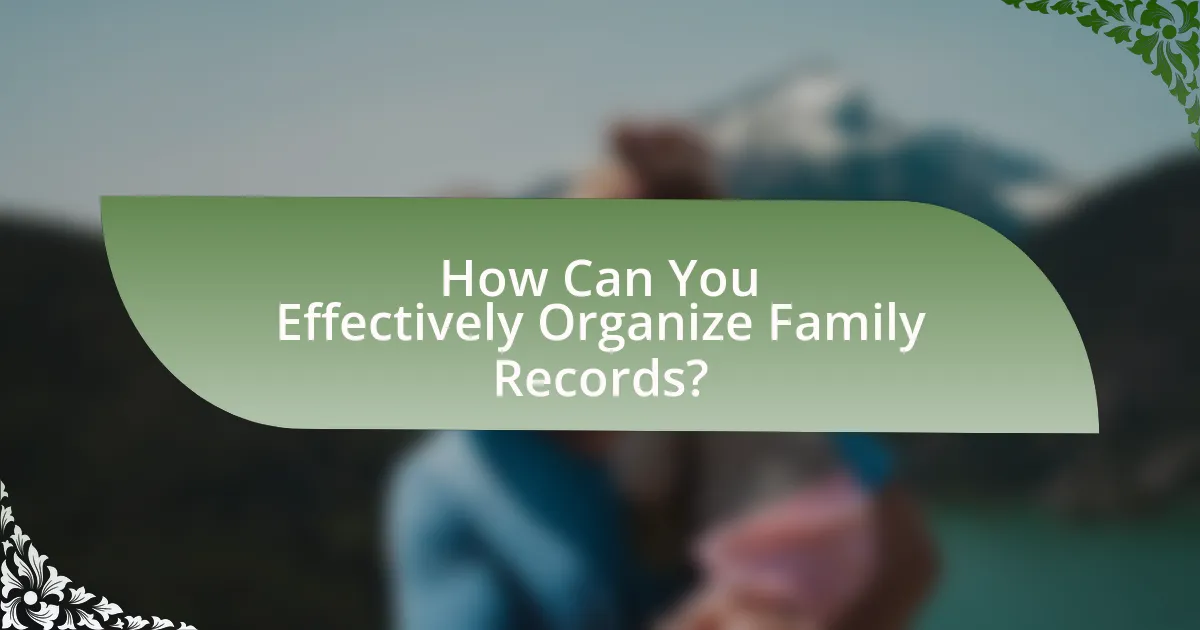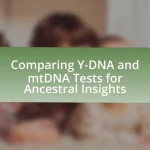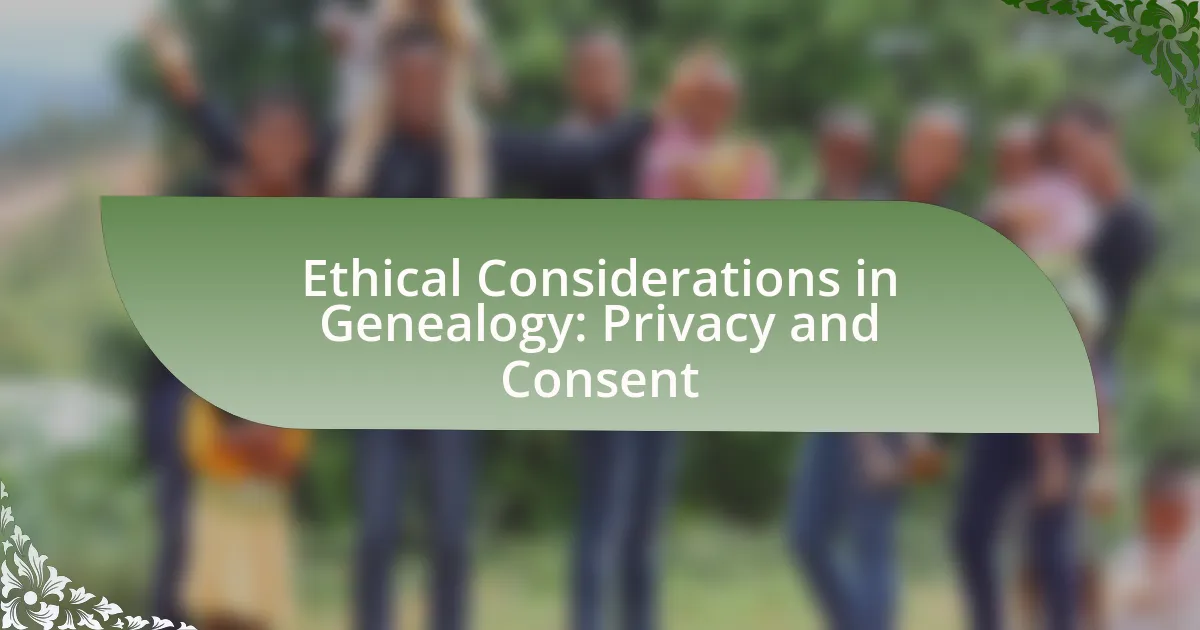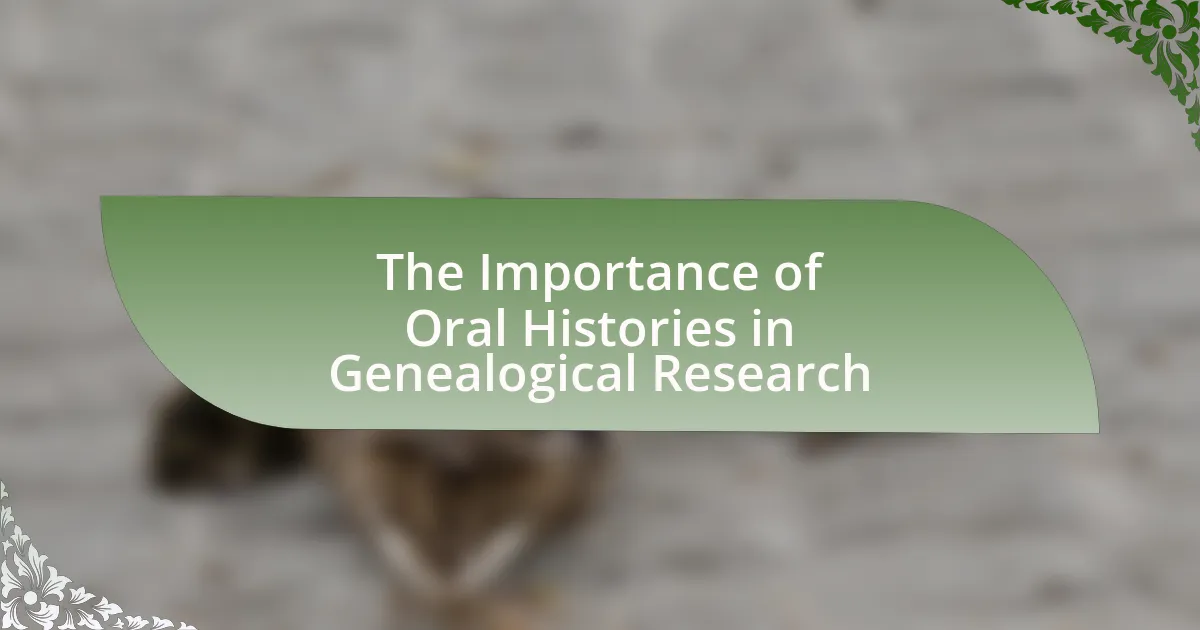Family records encompass essential documents and artifacts that capture a family’s history, lineage, and significant life events, including birth certificates, marriage licenses, and photographs. These records are crucial for understanding heritage, fostering a sense of identity, and serving as resources for genealogical research and legal matters. The article outlines the importance of organizing and preserving family records for future generations, detailing effective methods for categorization, digitization, and storage, while addressing common challenges families face in maintaining these records. Additionally, it emphasizes the role of storytelling and family reunions in sharing history, ensuring that valuable familial connections and narratives are passed down effectively.
What are Family Records and Why are They Important?

Family records are documents and artifacts that capture the history, lineage, and significant events of a family, including birth certificates, marriage licenses, photographs, and family trees. They are important because they provide a sense of identity, continuity, and belonging, allowing individuals to understand their heritage and familial connections. Additionally, family records serve as vital resources for genealogical research, legal matters, and preserving cultural traditions, thereby ensuring that future generations have access to their ancestry and family stories.
How do family records contribute to personal and family history?
Family records significantly contribute to personal and family history by providing documented evidence of lineage, relationships, and significant life events. These records, such as birth certificates, marriage licenses, and family trees, create a comprehensive narrative of a family’s past, allowing individuals to trace their ancestry and understand their heritage. For instance, genealogical research often relies on such documents to establish connections between generations, revealing patterns of migration, occupation, and cultural practices. This documentation not only enriches personal identity but also fosters a sense of belonging and continuity within families.
What types of information can be found in family records?
Family records typically contain vital information such as birth, marriage, and death dates, along with names of family members and their relationships. These records may also include details about family lineage, historical events, and personal anecdotes that provide context to the family’s history. Additionally, family records can encompass documents like census records, wills, and photographs, which further enrich the understanding of familial connections and heritage.
Why is preserving family records essential for future generations?
Preserving family records is essential for future generations because it ensures the continuity of family history and identity. These records provide valuable insights into ancestry, cultural heritage, and personal stories that shape familial connections. For instance, genealogical research shows that understanding one’s family background can foster a sense of belonging and identity, as evidenced by studies indicating that individuals with knowledge of their family history often report higher levels of self-esteem and resilience.
What challenges do families face in organizing records?
Families face several challenges in organizing records, including lack of time, insufficient knowledge of organization methods, and emotional attachment to documents. The time constraint often leads to procrastination, making it difficult for families to dedicate the necessary hours to sort and categorize their records. Additionally, many families may not be familiar with effective organizational systems, which can result in confusion and disarray. Emotional attachment to certain documents can hinder the decision-making process, as families may struggle to part with items that hold sentimental value, even if they are not essential. These challenges can complicate the preservation of important family records for future generations.
How can the volume of records complicate organization?
The volume of records can complicate organization by overwhelming systems and processes designed to manage information. When there is an excessive amount of records, it becomes challenging to categorize, retrieve, and maintain them efficiently. For instance, a study by the International Association for Information and Data Quality indicates that organizations with large volumes of data often face difficulties in data integrity and accessibility, leading to inefficiencies and potential loss of important information. This complexity can result in increased time spent on locating records, higher chances of misfiling, and greater difficulty in ensuring that all records are preserved appropriately for future generations.
What common issues arise when trying to preserve family records?
Common issues that arise when trying to preserve family records include deterioration of physical documents, loss of digital files, and lack of organization. Deterioration occurs due to environmental factors such as humidity, light exposure, and temperature fluctuations, which can damage paper and photographs. Loss of digital files often happens because of hardware failures, accidental deletions, or outdated technology that renders files inaccessible. Additionally, a lack of organization can lead to confusion and difficulty in locating important records, making it challenging to maintain a comprehensive family history.
How Can You Effectively Organize Family Records?

To effectively organize family records, create a systematic filing system that categorizes documents by type, such as birth certificates, marriage licenses, and financial records. This method allows for easy retrieval and ensures that important information is not lost. Utilizing digital tools, such as cloud storage or dedicated software, can enhance organization by providing secure access and backup options. According to the National Archives, maintaining organized records helps preserve family history and facilitates easier sharing with future generations.
What steps should be taken to start organizing family records?
To start organizing family records, begin by gathering all existing documents, including birth certificates, marriage licenses, and financial records. This initial step ensures that you have a comprehensive collection of important information. Next, categorize these documents into specific groups such as vital records, legal documents, and financial statements, which facilitates easier access and management. After categorization, create a filing system, either physical or digital, to store these records securely. For physical records, use labeled folders or binders, while for digital records, consider cloud storage solutions for backup and accessibility. Regularly review and update the records to maintain their accuracy and relevance, ensuring that your family history remains organized and preserved for future generations.
How can you categorize different types of family records?
Family records can be categorized into several types, including vital records, legal documents, historical records, and personal memorabilia. Vital records encompass birth, marriage, and death certificates, which are essential for establishing identity and lineage. Legal documents include wills, property deeds, and adoption papers, serving as formal records of legal status and ownership. Historical records consist of family trees, photographs, and letters that provide context and narrative to family history. Personal memorabilia includes items like diaries, scrapbooks, and heirlooms that hold sentimental value and personal stories. Each category serves a distinct purpose in preserving family history and identity.
What tools and resources can assist in the organization process?
Digital tools such as cloud storage services, document management software, and genealogy databases can significantly assist in the organization process of family records. Cloud storage services like Google Drive and Dropbox allow users to store and access documents from anywhere, ensuring that important records are preserved and easily retrievable. Document management software, such as Evernote or Microsoft OneNote, helps in categorizing and tagging documents for efficient organization. Genealogy databases like Ancestry.com and FamilySearch provide resources for organizing family history and connecting with relatives, facilitating the preservation of family records. These tools enhance accessibility, security, and systematic organization of family documents, making it easier to maintain records for future generations.
How can digital tools enhance the organization of family records?
Digital tools enhance the organization of family records by providing efficient storage, easy access, and streamlined sharing capabilities. These tools, such as cloud storage services and genealogy software, allow families to digitize documents, photographs, and other records, ensuring they are preserved in a secure and organized manner. For instance, using platforms like Ancestry or MyHeritage enables users to create family trees and link historical documents, making it easier to trace lineage and maintain comprehensive family histories. Additionally, digital tools often include features for tagging, searching, and categorizing records, which significantly reduces the time spent locating specific information compared to traditional paper-based methods.
What are the benefits of using digital storage solutions?
Digital storage solutions provide enhanced accessibility, security, and efficiency for managing family records. These solutions allow users to access documents from anywhere with an internet connection, facilitating easy sharing among family members. Additionally, digital storage often includes encryption and backup options, which protect sensitive information from loss or unauthorized access. According to a study by the International Data Corporation, organizations that adopt digital storage solutions can reduce data retrieval times by up to 80%, demonstrating significant efficiency improvements.
How can you ensure the security of digital family records?
To ensure the security of digital family records, implement strong encryption methods for data storage and transmission. Encryption protects sensitive information by converting it into a format that can only be read by authorized users with the correct decryption key. Additionally, utilize secure cloud storage services that offer end-to-end encryption and two-factor authentication, which adds an extra layer of security by requiring a second form of verification before access is granted. Regularly update passwords and use complex combinations to further safeguard access to these records. According to a 2021 study by Cybersecurity Ventures, 60% of small businesses that suffer a cyber attack go out of business within six months, highlighting the importance of robust security measures for digital records.
What Methods are Best for Preserving Family Records?

The best methods for preserving family records include digitization, proper storage, and regular backups. Digitization involves scanning physical documents and photographs to create digital copies, which can be stored on cloud services or external hard drives, ensuring accessibility and protection against physical deterioration. Proper storage entails using acid-free folders and archival boxes to protect physical records from environmental damage, such as moisture and light. Regular backups of digital files to multiple locations, including cloud storage and external drives, safeguard against data loss due to hardware failure or accidental deletion. These methods are supported by archival best practices, which emphasize the importance of both digital and physical preservation to maintain the integrity and accessibility of family records over time.
How can physical records be preserved for the long term?
Physical records can be preserved for the long term by storing them in a controlled environment with stable temperature and humidity levels. Maintaining a temperature between 65-70°F and humidity levels around 30-50% helps prevent deterioration. Additionally, using acid-free materials for storage, such as boxes and folders, protects records from chemical damage. Regularly inspecting the records for signs of deterioration and handling them with clean hands or gloves further ensures their longevity. According to the Library of Congress, proper archival storage can significantly extend the lifespan of physical documents, often preserving them for centuries.
What materials are best for storing physical documents?
Archival-quality materials are best for storing physical documents. These materials include acid-free paper, polyester sleeves, and archival boxes, which prevent deterioration and damage over time. Acid-free paper is specifically designed to resist yellowing and brittleness, while polyester sleeves provide a protective layer against dust and physical wear. Archival boxes offer a safe storage environment that shields documents from light and humidity, ensuring long-term preservation. Studies in archival science emphasize the importance of using these materials to maintain the integrity of historical documents, confirming their effectiveness in preserving valuable records for future generations.
How can you protect physical records from environmental damage?
To protect physical records from environmental damage, store them in a controlled environment with stable temperature and humidity levels. Ideal conditions include a temperature range of 65-70°F and relative humidity of 30-50%. Additionally, use acid-free archival boxes and folders to prevent deterioration from pollutants and acidity. Proper shelving that keeps records off the ground can also protect against water damage. Research indicates that maintaining these conditions significantly extends the lifespan of documents, as fluctuations in temperature and humidity can lead to mold growth and paper degradation.
What are the best practices for digitizing family records?
The best practices for digitizing family records include using high-quality scanning equipment, organizing documents before digitization, and employing consistent file naming conventions. High-quality scanners ensure that images are clear and legible, which is crucial for preserving details in documents. Organizing records into categories, such as birth certificates, marriage licenses, and photographs, simplifies the digitization process and enhances retrieval later. Consistent file naming conventions, such as including dates and descriptions, facilitate easy searching and sorting of digital files. Additionally, backing up digital files in multiple locations, such as cloud storage and external hard drives, protects against data loss. These practices are supported by archival standards that emphasize the importance of clarity, organization, and redundancy in digital preservation.
How do you choose the right equipment for digitization?
To choose the right equipment for digitization, assess the specific types of materials you need to digitize, such as photographs, documents, or audio recordings. For photographs and documents, high-resolution scanners with at least 300 DPI are recommended to capture fine details, while for audio, a quality digital audio recorder is essential to ensure clarity. Additionally, consider the format you wish to digitize into; for instance, PDFs for documents and JPEGs for images. Research indicates that using equipment with built-in editing features can streamline the process, as noted in the “Digital Preservation Handbook” by the Digital Preservation Coalition.
What steps should be followed to ensure high-quality digital copies?
To ensure high-quality digital copies, one should follow these steps: use a high-resolution scanner or camera to capture images, select appropriate file formats such as TIFF or PNG for lossless quality, and maintain consistent lighting and settings during the scanning process. High-resolution scanning captures more detail, while lossless formats prevent data loss. Consistent lighting reduces shadows and glare, ensuring clarity in the digital copies.
How Can You Share Family Records with Future Generations?

You can share family records with future generations by digitizing the documents and storing them in accessible online platforms. Digitization allows for preservation against physical deterioration, while online storage solutions, such as cloud services, enable easy sharing and access for family members regardless of location. According to a study by the National Archives, digitized records can be preserved for over 100 years without significant loss of quality, making this method both effective and reliable for long-term sharing.
What strategies can be used to engage younger family members with records?
To engage younger family members with records, interactive storytelling can be employed, allowing them to connect emotionally with family history. This strategy involves sharing personal anecdotes and experiences related to the records, making the information relatable and engaging. For instance, using digital platforms to create multimedia presentations or family trees can visually captivate younger audiences, enhancing their interest in the records. Research indicates that interactive learning methods significantly improve retention and engagement, particularly among younger demographics, as they often prefer visual and hands-on experiences over traditional methods.
How can storytelling enhance the sharing of family history?
Storytelling enhances the sharing of family history by making it more engaging and relatable, which fosters emotional connections among family members. When stories are shared, they provide context and meaning to historical events, allowing individuals to understand their heritage on a personal level. Research indicates that narratives can improve memory retention; for instance, a study published in the journal “Memory” found that people are more likely to remember information presented in story form compared to facts alone. This ability to remember enhances the transmission of family history, ensuring that future generations have a richer understanding of their lineage.
What role do family reunions play in sharing records?
Family reunions serve as vital opportunities for sharing records among relatives. During these gatherings, family members can exchange historical documents, photographs, and personal stories that contribute to a collective understanding of their ancestry. This face-to-face interaction fosters collaboration in compiling family trees and preserving important information, ensuring that records are not only shared but also accurately documented for future generations.
What are some practical tips for maintaining family records over time?
To maintain family records over time, digitize documents and store them in multiple secure locations. Digitization preserves records against physical deterioration and allows for easy sharing among family members. Utilizing cloud storage services, such as Google Drive or Dropbox, ensures that records are accessible from anywhere and protected against local disasters. Regularly update and back up these digital files to prevent data loss. Additionally, create a physical filing system with labeled folders for important documents, ensuring that they are stored in a climate-controlled environment to minimize damage. Regularly review and purge unnecessary documents to keep the collection manageable.
How often should family records be reviewed and updated?
Family records should be reviewed and updated at least once a year. Regular annual reviews ensure that important information, such as changes in family status, contact details, and significant life events, is accurately captured. This practice aligns with recommendations from genealogical organizations, which emphasize the importance of maintaining current records to preserve family history effectively.
What common mistakes should be avoided in record preservation?
Common mistakes to avoid in record preservation include improper storage conditions, neglecting digital backups, and failing to regularly update preservation methods. Improper storage conditions, such as exposure to humidity, light, and temperature fluctuations, can damage physical records over time. Neglecting digital backups can lead to loss of important documents if original files become corrupted or lost. Additionally, failing to regularly update preservation methods can result in outdated practices that do not adequately protect records from evolving threats, such as technological obsolescence.




